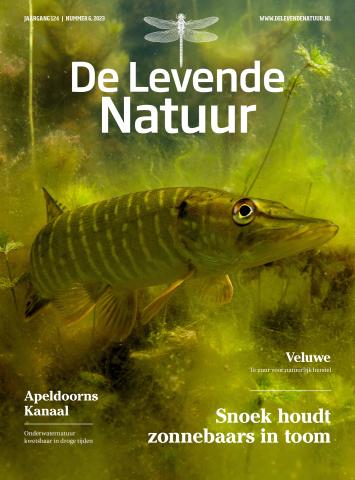De Levende Natuur nummer 6 van 2023 (English summary)
Afbeelding

Ecosystem of the Apeldoorns Kanaal vulnerable during warm periods
The Apeldoorns Kanaal is one of the cleanest canals in the Netherlands. One of the reasons is the flow of clean water into the canal from some small manmade brooks, in particular the Vrijenbergerspreng. This gives the canal a unique aquatic ecosystem. One of the most important species in this canal is the floating water-plantain.
To compensate effects of hot and dry summers, water rich in sulfate and carbonates is let into the canal from the river IJssel. This degrades the unique ecosystem. In the past twelve years the effects have been monitored. There is a tendency that the water quality is changing. Complex and dynamic interactions between water, bottom and aquatic ecosystem are still not fully understood, and more frequent warm periods hinder the recovery of the system.
What do Critical performance indicators (KPIs) tell us about biodiversity?
Critical performance indicators (KPIs) are currently being developed for various agricultural sectors to make the sustainability performance of agricultural businesses more transparent and set clear goals to aim for. For the dairy farming sector, a set of KPI’s was developed, called the biodiversity monitor dairy farming (BBM), to rate the sustainability and biodiversity performance of individual dairy farms. This system enables stakeholders to reward farmers for meeting specific targets, while giving them freedom on how they achieve these. Biodiversity itself is not a KPI. In this research we studied, for the first time, how the performance of thirty dairy farms against the KPI set (BBM), related to a number of biodiversity parameters (birds and butterflies), as well as soil health and water quality in the field. We found some positive relationships between performance against the KPIs and biodiversity, but the relationships are weak. This research provides the first, tentatively positive, indication that the BBM-system can be used effectively to reward farmers for their biodiversity efforts. In addition, it provides important insights for further refinement of this policy instrument.
Pikes keep pumpkinseed sunfish in check
In 2012, over 100.000 pumpkinseed sunfish were caught and removed from five moorland pools in the Mastbos nature reserve. To prevent the populations from recovering Eurasian pike was introduced. Between 2012 and 2022, monitoring was conducted to assess the effectiveness of these measures and determine whether native amphibians and invertebrates had recovered.
Pike were successful in preventing pumpkinseed populations to recover to their former numbers. However, a series of dry summers resulted in increased pumpkinseed recruitment and possibly lower pike numbers, requiring additional stocking. The combination of fish and dry summers hindered the recovery of amphibian populations. However, aquatic macro-invertebrates successfully recovered, with many taxonomic groups and characteristic species increasing in number or newly appearing.
Reducing the pumpkinseed population and introducing native predators seems an effective approach for managing this invasive species. Nevertheless, caution should be exercised, and alternative solutions explored when dealing with populations of endangered amphibians or in situations where their presence or restoration is desired.
Veluwe region is too acid to count on natural recovery
Atmospheric nitrogen deposition has aggravated the acidification of soils. Grid sampling revealed that the pH-KCl of the northern part of the Veluwe was less than 3 in 36 % of the samples. Such values tend to be associated with toxic levels of aluminum and the loss of plant nutrients. This suspicion is confirmed by the reduced vitality and presence of several plant and animal species. The natural weathering of soils is insufficient to compensate for the lost nutrients. This makes human interference inevitable, including the applications of nutrients. As yet this is restricted to spreading slow-release materials. However, the present state of nature may need to consider the use of cheaper and more effective materials including agricultural fertilizers.

